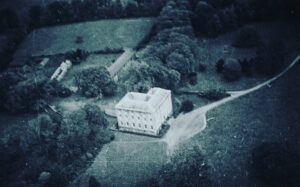Architecture in the World of Elizabeth Bowen
by
17 October, 2022

The Anglo Irish writer Elizabeth Bowen was born in Dublin in 1899. Her first seven winters were spent in the city that she describes as “a bold Italianate plan in tricky Celtic light”. The city left a profound mark on her sensibility, with its “climatic moodiness” where “all stood for stability”; it was a city she experienced intimately, before her father eventually took charge of the family’s country estate. There she would pass her summers, at Bowen’s Court, County Cork in the south west of Ireland. Subsequently her life would be variously spent living between there and the south of England. She would eventually inherit, but unable to sustain the upkeep of the estate, she finally departed her beloved home as a widow, in 1958, never to see it again, for she had passed the great house to a local farmer who demolished the building in 1960. Nothing remains to this day except the partial landscape that surrounded the house, the land having been returned to agriculture. In spite of these circumstances a faint imprint remains clearly felt through writing, the Big House its social, cultural, historical and economic life captured in her many writings.
Bowen is noted for her non-fiction as well as fictional writings. Bowen’s Court (1942), is a historical account of the Bowen country estate, her ancestors, how they arrived in Ireland along with detailed descriptions of the building and its rooms. She was a writer for whom setting and atmosphere are key components establishing the scene in which events or social exchange takes place, be it an intimate landscape or broad territory, an urban situation or the condition and character of a room. It is through these means she comes close to architecture, elaborating the condition of life lived almost always within it’s necessary frame or background.

Still from The Last September, 2000
Invariably there are descriptions of the lifestyle she would have experienced, relations between other great houses, family visits, social events, landscapes local towns, an arrangement of architectural relations both real and of the mind, personal to her own felt experience of place, time, events and their evocative framing. We witness this in reality in Bowens Court and in the fictional setting of The Last September (1929), setting the scene of the demise of the great house in Ireland at a turbulent point in the country’s history.
Bowen’s short stories rely very much on a richly-described, evocative setting, framed by architecture or landscape. Somehow nature always appears affected by the human hand, either disturbed to make way for “the new house” or designed to establish a setting for human action. She is deeply attuned to the effect of light and shadow, form and presence, the framing and containing of the protagonist(s) by architecture. These are but some of the many sensitivities and qualities that place Bowen in a position to be appreciated more closely by the discipline and imagination of architecture.